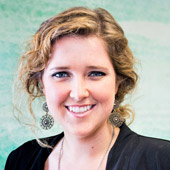Cognitive Neuroscientist, Leading Expert on Human Decision-Making & Emotion; Award-Winning Author of "The Influential Mind" & "The Optimism Bias"
Dr. Tali Sharot Biography
Professor Tali Sharot is a leading expert on decision-making and emotion. Sharot combines research in behavioral economics, psychology, and neuroscience to reveal the forces that shape our decisions and beliefs. Her award winning books - "The Influential Mind" and "The Optimism Bias" – have been widely praised, including by the New York Times, Forbes and more.
Her speaking audiences also include Google, Microsoft, The European Parliament, NATO, Goldman Sachs, Prudential, the World Economic Forum, among many others. She has written for top publications including TIME magazine, The Guardian, and the New York Times.
Professor Sharot has been a guest multiple times on CNN, MSNBC among others and co-presented BBC’s Science Club. She held prestigious fellowships from the British Academy and Wellcome Trust.
Professor Sharot currently divides her time between MIT and University College London where she directs the Affective Brain Lab. Her TED talks have been viewed over 17 million times.
Contact a speaker booking agent to check availability on Dr. Tali Sharot and other top speakers and celebrities.
Dr. Tali Sharot Speaking Topics
-
Mental Time Travel: optimism, imagination, and how thinking about the future alters the present
As our world is rapidly changing, companies and governments are occupied with the question of what the future holds. Imagining the future is a marvellous ability that can foster creativity and innovation. But our capacity to think about the future is also constrained
• by the past, by what we hope will be true and by our current beliefs. In this talk, Sharot shares what science tells us about the human ability for “mental time travel”; how we can use this skill to our advantage avoiding poor planning and systematic mispredictions. Sharot builds on her pioneering discoveries in this area, described in her book ‘The Optimism Bias’, to explain how we can better prepare for, and shape, the future, today.
-
Influence: How You Affect the Opinions, Decisions and Desires of Others
Part of our daily job as humans is to affect others; we advise our clients, guide our patients, teach our children and inform our online followers. Yet, science shows we systematically fall on to suboptimal habits when trying to change others' beliefs
• from insisting the other is wrong to exerting control. Based on her award-winning book, The Influential Mind, internationally acclaimed behavioral neuroscientist, Tali Sharot, explains how an attempt to alter beliefs will be successful only if it is well-matched with the core elements that govern how we think and feel. By understanding the minds and brains of those around us, we become better at advising and communicating information.
Dr. Tali Sharot Videos

Highlights: Dr. Tali Sharot at JFN 2019
Dr. Sharot is a a leading expert on human decision-making, optimism and emotion, combining research in psychology, behavioral economics, and...



-
How do I book Dr. Tali Sharot to speak at my event?
Our experienced booking agents have successfully helped clients around the world secure speakers like Dr. Tali Sharot for speaking engagements, personal appearances, product endorsements, or corporate entertainment since 2002. Click the Check Availability button above and complete the form on this page to check availability for Dr. Tali Sharot, or call our office at 1.800.698.2536 to discuss your upcoming event. One of our experienced agents will be happy to help you get speaking fee information and check availability for Dr. Tali Sharot or any other speaker of your choice. -
What are the speaker fees for Dr. Tali Sharot
Speaking fees for Dr. Tali Sharot, or any other speakers and celebrities, are determined based on a number of factors and may change without notice. The estimated fees to book Dr. Tali Sharot are $20,000 - $30,000 for live events and $10,000 - $20,000 for virtual events. For the most current speaking fee to hire Dr. Tali Sharot, click the Check Availability button above and complete the form on this page, or call our office at 1.800.698.2536 to speak directly with an experienced booking agent. -
What topics does Dr. Tali Sharot speak about?
Dr. Tali Sharot is a keynote speaker and industry expert whose speaking topics include Author, Culture, Disruptive Thinking, Education, Ethics & Integrity, Innovation, Neuroscience, Non-Fiction Authors, Psychology, Science, Social Sciences, Technology, Thought Leadership, Women in Tech -
Where does Dr. Tali Sharot travel from?
Dr. Tali Sharot generally travels from Boston, MA, USA, but can be booked for private corporate events, personal appearances, keynote speeches, or other performances. For more details, please contact an AAE Booking agent. -
Who is Dr. Tali Sharot’s agent?
AAE Speakers Bureau has successfully booked keynote speakers like Dr. Tali Sharot for clients worldwide since 2002. As a full-service speaker booking agency, we have access to virtually any speaker or celebrity in the world. Our agents are happy and able to submit an offer to the speaker or celebrity of your choice, letting you benefit from our reputation and long-standing relationships in the industry. Please click the Check Availability button above and complete the form on this page including the details of your event, or call our office at 1.800.698.2536, and one of our agents will assist you to book Dr. Tali Sharot for your next private or corporate function. -
What is a full-service speaker booking agency?
AAE Speakers Bureau is a full-service speaker booking agency, meaning we can completely manage the speaker’s or celebrity’s engagement with your organization from the time of booking your speaker through the event’s completion. We provide all of the services you need to host Dr. Tali Sharot or any other speaker of your choice, including offer negotiation, contractual assistance, accounting and billing, and event speaker travel and logistics services. When you book a speaker with us, we manage the process of hosting a speaker for you as an extension of your team. Our goal is to give our clients peace of mind and a best-in-class service experience when booking a speaker with us. -
Why is AAE Speakers Bureau different from other booking agencies?
If you’re looking for the best, unbiased speaker recommendations, paired with a top-notch customer service experience, you’re in the right place. At AAE Speakers Bureau, we exclusively represent the interests of our clients - professional organizations, companies, universities, and associations. We intentionally do not represent the speakers we feature or book. That is so we can present our clients with the broadest and best performing set of speaker options in the market today, and we can make these recommendations without any obligation to promote a specific speaker over another. This is why when our agents suggest a speaker for your event, you can be assured that they are of the highest quality with a history of proven success with our other clients.
Dr. Tali Sharot is a keynote speaker and industry expert who speaks on a wide range of topics such as Mental Time Travel: optimism, imagination, and how thinking about the future alters the present , Influence: How You Affect the Opinions, Decisions and Desires of Others, Smart Choice: Making Better Decisions using behavioural science, The Business of Moving Others: Using the New Science of the Mind to Induce Behavioral Change, Moving Forward and Raising our Heads out of the Sand – Effective Decision Making and How to Avoid Pitfalls by Managing the “Ostridge Effect”. The estimated speaking fee range to book Dr. Tali Sharot for your event is $20,000 - $30,000. Dr. Tali Sharot generally travels from Boston, MA, USA and can be booked for (private) corporate events, personal appearances, keynote speeches, or other performances. Similar motivational celebrity speakers are Nataly Kogan, Shawn Achor, Dr. Jackie Freiberg, Erica Dhawan and Adrian Gostick. Contact All American Speakers for ratings, reviews, videos and information on scheduling Dr. Tali Sharot for an upcoming live or virtual event.
This website is a resource for event professionals and strives to provide the most comprehensive catalog of thought leaders and industry experts to consider for speaking engagements. A listing or profile on this website does not imply an agency affiliation or endorsement by the talent.
All American Entertainment (AAE) exclusively represents the interests of talent buyers, and does not claim to be the agency or management for any speaker or artist on this site. AAE is a talent booking agency for paid events only. We do not handle requests for donation of time or media requests for interviews, and cannot provide celebrity contact information.
If you are the talent and wish to request a profile update or removal from our online directory, please submit a profile request form.































